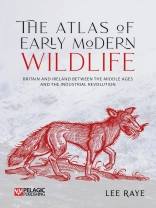What was the state of wildlife in Britain and Ireland before modern records began? The Atlas of Early Modern Wildlife looks at the era before climate change, before the intensification of agriculture, before even the Industrial Revolution. In the sixteenth to eighteenth centuries, beavers still swim in the River Ness. Isolated populations of wolves and lynxes linger in the uplands. Sea eagles are widespread around the coasts. Wildcats and pine martens remain common in the Lake District.
In this ground-breaking volume, the observations of early modern amateur naturalists, travellers and local historians are gathered together for the very first time. Drawing on more than 10, 000 records from across Britain and Ireland, the book presents maps and notes on the former distribution of over 150 species, providing a new baseline against which to discuss subsequent declines and extinctions, expansions and introductions. A guide to identification describes the reliable and unreliable names of each species, including the pre-Linnaean scientific nomenclature, as well as local names in early modern English and, where used in the sources, Irish, Scots, Scottish Gaelic, Welsh, Cornish and Norn.
Raising a good number of questions at the same time as it answers many others, this remarkable resource will be of great value to conservationists, archaeologists, historians and anyone with an interest in the natural heritage of Britain and Ireland.
Table of Content
Acknowledgements
Copyright permissions
INTRODUCTION
Scope
Early modern natural history
Key sources
Other sources
Interpreting the sources
Vernacular languages
Trend since 1772
Geographical bias of top-quality records
Identifying absence
Comparison with modern data
How to read the maps
MAMMALS
Rabbits and hares
Rodents
Carnivores
Ungulates
Seals
Cetaceans
BIRDS
Waterfowl
Game birds
Divers
Petrels and shearwaters
Herons, storks and ibises
Gannets and cormorants
Raptors
Bustards
Cranes
Waders, gulls and auks
Owls
Falcons
Perching birds
FISHES
Lampreys
Sturgeons
Carps
Pikes
Smelts
Salmonids
Perches
Sharks
Skates and rays
Eels
Herrings
White Fishes
Anglers
Mullets
Gurnards
Sandeels
Bass
Open-water Fishes
Flat Fishes
AMPHIBIANS AND REPTILES
Amphibians
Reptiles
INVERTEBRATES
Molluscs
Crustaceans
Echinoderms
CONCLUSIONS
Overall analysis
Groups that have expanded their range
Groups that have reduced their range
Problems with using the Little Ice Age as a baseline
References
Index and glossary of species names












